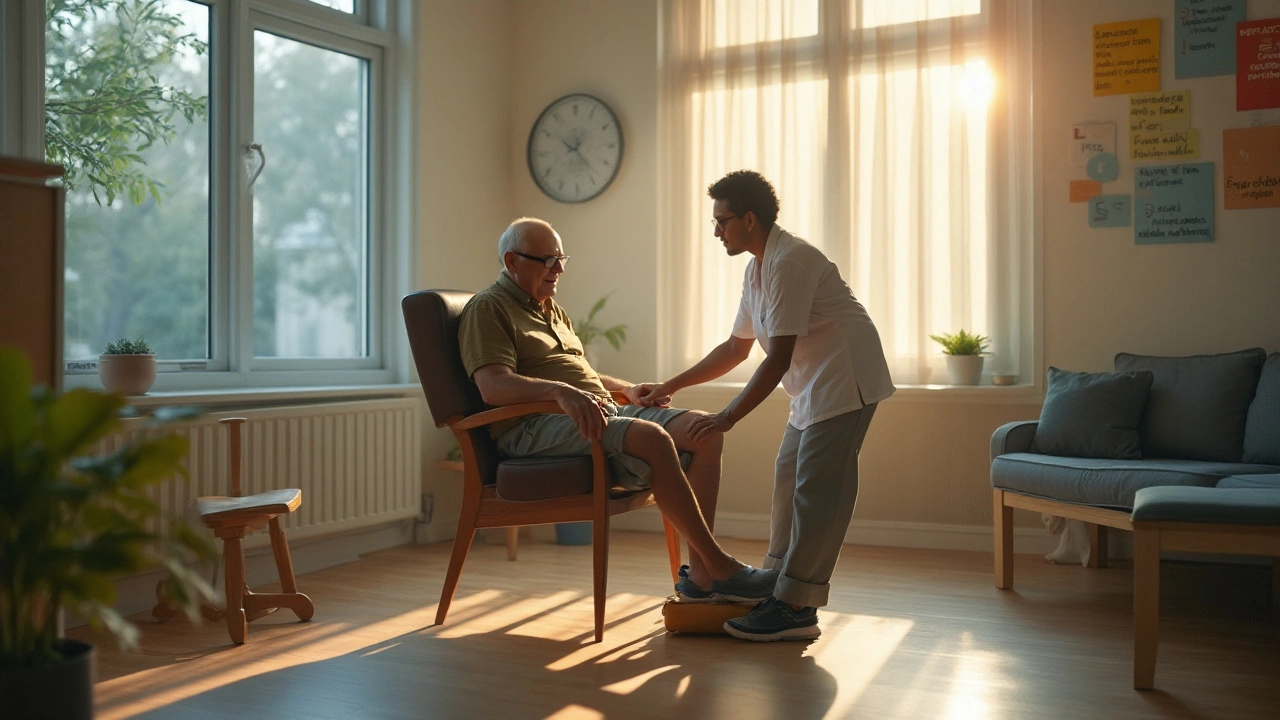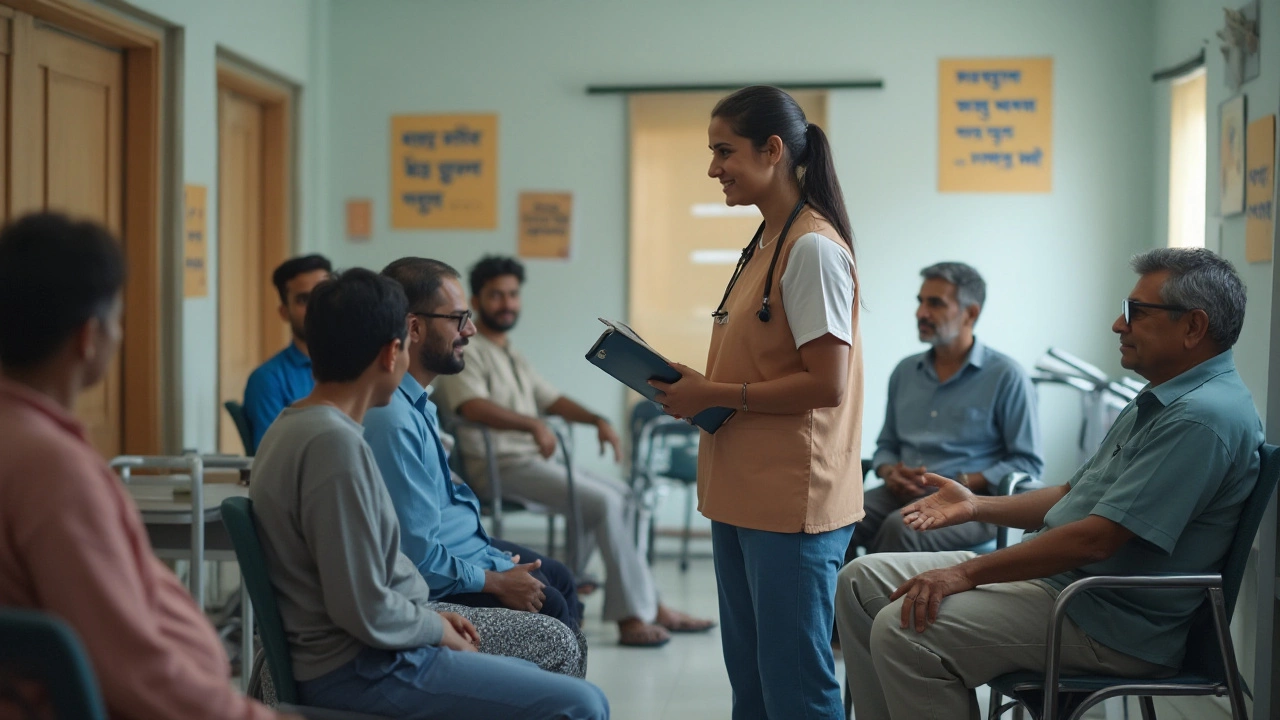
For those stepping onto the path of knee replacement surgery, stiffness might undoubtedly become an unexpected companion on the road to recovery. The journey often raises questions: How long does stiffness last, and what can be done to alleviate it effectively? Understanding the nature of stiffness after such a major surgery is crucial to carving out a successful and smooth recovery.
In this article, we'll explore the various facets of stiffness following knee replacement surgery, examining timelines and the factors that could make recovery faster or slower. By familiarizing yourself with smart strategies and effective exercises, your post-surgery process can become significantly more comfortable. We'll also discuss essential tips to manage stiffness, factors that influence healing, and how patience plays a pivotal role in this entire process.
- Recovery Timeline After Knee Replacement
- Factors Influencing Recovery Speed
- Tips to Manage Knee Stiffness
- Setting Realistic Expectations
Recovery Timeline After Knee Replacement
Embarking on the journey after a knee replacement involves navigating through a series of carefully staged milestones. For many, the first few weeks can be daunting, filled with both excitement and apprehension as they wonder about regaining full mobility. Swelling and stiffness after surgery are quite common in the early stages. Initially, it will take some time for the knee to settle down after the procedure. It's crucial to understand that recovery from knee replacement is not an overnight miracle but a gradual transition, building day by day.
Right after the operation, patients often spend a few days in the hospital under close observation. During this period, medical professionals offer guidance on initiating movement. Within these initial days, they encourage walking with aids like walkers or crutches. The goal is to gently enhance muscle strength while guarding the new knee. As tempting as it may be to rest, early motion is pivotal in counteracting stiffness and encouraging circulation. According to the American Academy of Orthopaedic Surgeons, patients usually resume normal daily activities within 3 to 6 weeks post-surgery, but this doesn't mean the knee feels completely "normal" yet.
From Weeks to Months: Progressing at Your Own Pace
From the month onward, a marked improvement begins to surface. Patients generally move to less-intensive mobility aids as they push beyond their initial recovery timeline. This progression varies significantly from person to person, dictated by factors like age, overall health, and adherence to prescribed physical therapy exercises. Strengthening the calf muscles, quadriceps, and stretching exercises become a standard part of the routine. Adhering to this regimen not only alleviates stiffness but also enhances flexibility.
Navigating through this period requires resilience and a positive outlook. By three months, many individuals can expect to return to less strenuous activities—like driving and perhaps even golfing or swimming with some modifications. For those seeking to return to more rigorous pursuits, patience is key as full recovery often spans a full year as noted by experts at John Hopkins Medicine. Notably, a year allows the rebuilt knee to adjust and accommodate increased engagement without imposing too much pressure or risk of injury.
"Knee replacement is a significant surgery, and understanding the personalized pace of recovery helps set more attainable goals," says Dr. Paul, a renowned orthopedic surgeon. "Communicating with health providers tirelessly to gauge your progress and make necessary adjustments is essential."
Understanding this timeline and knowing how to manage each stage grants patients a healthier recovery outlook. It's important to remain steady in the purpose of restoring the best possible knee function, adapting daily activities to fit within the newfound limits while generously capturing advancements achieved, no matter how small they may seem.
Measuring Recovery Expectations
Post-surgery horizons extend beyond mere physical rehabilitation; emotional fortitude plays an equally compelling role. While the eighth or ninth week might promise newfound strides, some patients may experience persistent pain and discomfort, a reality that requires coping strategies and mental ingenuity. Regular follow-ups allow health providers to address any lingering issues and adjust treatment plans to meet the personalized needs of the individual recoverers.
Statistics suggest that nearly 90% of people who undergo knee replacement report significantly reduced pain and improved joint function in the long run. This optimistic projection fuels the spirit to push through lingering stiffness, reinforcing that the path to recovery, albeit lengthy, is ultimately rewarding. In this healing process, perseverance, backed by correct information and tailored support, is the guiding light leading towards a bountiful life post-knee replacement.

Factors Influencing Recovery Speed
Knee replacement surgery is a significant procedure, and the rate at which individuals recover can vary widely. Several elements come into play when determining how quickly someone might regain full mobility and say goodbye to the dreaded stiffness. A predominant factor is the individual's overall health prior to the surgery. Patients who have maintained a balanced lifestyle and engaged in physical activity tend to experience a smoother recovery. This is because stronger muscles and a healthier cardiovascular system support faster healing and adaptation.
Meanwhile, age also takes on a pivotal role. Younger patients typically bounce back faster, likely due to their body's more robust regenerative capabilities. In contrast, older individuals may face longer recovery periods, as their tissues generally regenerate at a slower pace. Another vital consideration is the presence of comorbidities such as diabetes or arthritis. Certain conditions can impair circulation and healing, thereby prolonging stiffness and discomfort post-surgery. Stiffness after surgery may insist on lingering longer if such health conditions are left unmanaged.
The level of commitment to physiotherapy and exercise can greatly influence recovery as well. Regular, guided exercises strengthen the knee area and prevent stiffness from setting in too firmly. Therapeutic movements designed by professionals aid in increasing range of motion and functionality, thereby hastening one's return to daily activities. Conversely, neglecting such routines can lead to prolonged periods of stiffness and inhibited movement. A patient’s mental outlook should not be underplayed either, as maintaining a positive and proactive mindset is linked to improved recovery outcomes.
Interestingly, lifestyle habits such as smoking and drinking can also affect rehabilitation speed. Smoking, for instance, tends to reduce oxygen supply to tissues, while alcohol can interfere with the body's natural recovery processes. Patients who make the conscious decision to eliminate or reduce these habits usually find themselves on a faster track to rehabilitation. Pre-surgery preparation programs are becoming more common and include nutrition and exercise plans that prime patients for a quicker recovery.
"Rehabilitation is just as crucial as the surgery itself," states Dr. Jane Allen, a leading orthopedic surgeon. "Patients who adhere to their physical therapy regimens generally report less post-operative stiffness and a more enjoyable recovery journey."
Lastly, surgical techniques and prosthetic types can be just as decisive. Advanced surgical methods that require less invasive approaches can result in reduced stiffness and shorter recovery times. Similarly, the design and material of the knee prosthesis can affect how swiftly one recovers. Surgeons select these based on the patient's specific conditions and expectations from the surgery. These combined factors paint a comprehensive picture of how recovery speed post-knee replacement can be either hindered or propelled.

Tips to Manage Knee Stiffness
Experiencing stiffness after a knee replacement surgery is quite common and can be quite unsettling. The good news is there are many practical ways to manage and reduce this stiffness, helping you regain mobility and comfort. One of the most effective approaches is to establish a consistent exercise routine. Physical therapy usually plays a pivotal role in recovery. Engaging in gentle exercises, like straight leg raises and knee bends, can significantly help in maintaining movement. Remember: consistency is key here. Regular sessions tailored to your pace can work wonders in ensuring flexibility and strength return smoothly. Harness the guidance of a professional physical therapist to adjust these exercises to your specific recovery needs and limits.
Another invaluable tip is to keep track of your daily activities. Analyze what triggers stiffness and make necessary adjustments. If prolonged inactivity increases stiffness, short but frequent walks or movements can make a big difference. Hydration is another crucial factor. Water not only aids in overall health but also ensures joint lubricity, effectively minimizing stiffness. Additionally, keep an eye on your diet; incorporating anti-inflammatory foods such as ginger, turmeric, and omega-rich fish can provide added benefits.
According to Dr. Wendy L. Katz, chief of orthopedic surgery at St. John’s Health, "Recovery hinges largely on maintaining a balance between rest and activity. Strategic rest periods combined with consistent light exercise is often the golden rule for mitigating post-surgery stiffness."
Another potential technique is the use of heat therapy. Applying a warm compress or heating pad to the affected area for 15-20 minutes can aid in relaxing tense muscles and improving circulation, which can further reduce stiffness post-surgery. Some find that alternating between heat and cold therapy provides additional comfort. As always, consult with your healthcare provider before beginning any complementary treatments.
If medications have been prescribed to manage your post-surgery stiffness, ensure you are following the dosage and timing recommendations diligently. Overlooking medication schedules can lead to setbacks in recovery. Pain management drugs, anti-inflammatory medications, and sometimes muscle relaxants play a role in minimizing discomfort. However, these should always be taken under careful guidance to avoid any potential adverse effects.
Taking a holistic approach by considering mental well-being can also impact physical recovery. Stress and anxiety can exacerbate physical symptoms, so incorporating relaxation techniques such as meditation or gentle yoga exercises might be beneficial. Ensuring you get adequate sleep each night is essential, as restorative sleep fosters healing and reduces stress. Combining these practical strategies can create a comprehensive plan to tackle stiffness and enhance your rehabilitation journey, ultimately leading to a more satisfying recovery process.

Setting Realistic Expectations
Understanding what lies ahead after a knee replacement recovery improves the ability to set realistic expectations, a cornerstone for a smooth comeback. The surgery itself is a monumental step towards regaining lost mobility but realizing that recovery unfolds at its own pace is fundamental. Patients often enter the surgical journey with hopes of swift rehabilitation, only to find recovery riddled with its own challenges. A crucial component comes from knowing the body’s resilience, which helps balance enthusiasm with patience, both vital components on this journey.
In the first few weeks post-surgery, it is common to experience discomfort, stiffness after surgery, and even emotional ups and downs. Swelling and reduced range of motion could persist, reminding one that healing is not an overnight affair. With optimistic patience, it's important to shift focus from speed to quality; this slight change in perspective can profoundly impact mental and physical rehabilitation. According to Dr. Smith, a renowned orthopedic surgeon, "Every knee is unique, and so is the recovery. Patience and perseverance should be your constant companions."
The time it takes for stiffness to subside is contingent upon numerous factors. Age, general health conditions, and how committed you are to following rehabilitation protocols can all influence recovery. Despite a general timeline that may suggest a 6 to 12-month recovery period, some might experience relief sooner, while others may continue working towards gaining full mobility. Such variables underline why a personalized approach, tailored by healthcare providers, is often most beneficial. The cornerstone of an effective recovery plan focuses on flexibility exercises, strength development, and adaptability.
A careful blend of exercises can significantly affect the speed at which stiffness declines. Physical therapy plays an indispensable role, usually involving both home exercises and professional sessions. Many healthcare providers advise exercises three times a day during the initial recovery stages. Specific activities might include straight leg raises, knee bends, and calf pumps. Evening out these expectations helps prevent frustration and guides the individual toward progressive achievement instead.
Perhaps one of the most illuminating tools in setting expectations is real-world data. A survey among post-knee surgery individuals might show that, on average, about 70% report significant improvements within six months. This data can feel reassuring. Viewing these numbers should prepare patients mentally and encourage adherence to the established plan. While numbers provide insight, it is individual progress, measured not just by achievement but persistence, that should guide the journey.





Rohan Talvani
I am a manufacturing expert with over 15 years of experience in streamlining production processes and enhancing operational efficiency. My work often takes me into the technical nitty-gritty of production, but I have a keen interest in writing about medicine in India—an intersection of tradition and modern practices that captivates me. I strive to incorporate innovative approaches in everything I do, whether in my professional role or as an author. My passion for writing about health topics stems from a strong belief in knowledge sharing and its potential to bring about positive changes.
view all postsWrite a comment